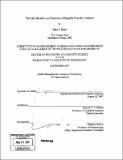The identification and function of English prosodic features
Author(s)
Breen, Mara E
DownloadFull printable version (13.88Mb)
Other Contributors
Massachusetts Institute of Technology. Dept. of Brain and Cognitive Sciences.
Advisor
Edward A. F. Gibson.
Terms of use
Metadata
Show full item recordAbstract
This thesis contains three sets of studies designed to explore the identification and function of prosodic features in English. The first set of studies explores the identification of prosodic features using prosodic annotation. We compared inter-rater agreement for two current prosodic annotation schemes, ToBI (Silverman, et al., 1992) and RaP (Dilley & Brown, 2005) which provide guidelines for the identification of English prosodic features. The studies described here survey inter-rater agreement for both novice and expert raters in both systems, and for both spontaneous and read speech. The results indicate high agreement for both systems on binary classification, but only moderate agreement for categories with more than two levels. The second section explores an aspect of the function of prosody in determining the propositional content of a sentence by investigating the relationship between syntactic structure and intonational phrasing. The first study tests and refines a model designed to predict the intonational phrasing of a sentence given the syntactic structure. In further analysis, we demonstrate that specific acoustic cues-word duration and the presence of silence after a word, can give rise to the perception of intonational boundaries. The final set of experiments explores the relationship between prosody and information structure, and how this relationship is realized acoustically. In a series of four experiments, we manipulated the information status of elements of declarative sentences by varying the questions that preceded those sentences. We found that all of the acoustic features we tested-duration, f0, and intensity-were utilized by speakers to indicate the location of an accented element. However, speakers did not consistently indicate differences in information status type (wide focus, new information, contrastive information) with the acoustic features we investigated.
Description
Thesis (Ph. D.)--Massachusetts Institute of Technology, Dept. of Brain and Cognitive Sciences, 2007. Includes bibliographical references (leaves 98-102).
Date issued
2007Department
Massachusetts Institute of Technology. Department of Brain and Cognitive SciencesPublisher
Massachusetts Institute of Technology
Keywords
Brain and Cognitive Sciences.